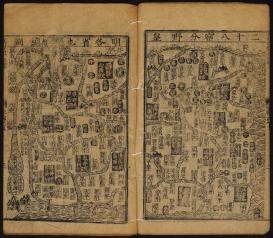Field allocation, fenye 分野 is the traditional Chinese theory of the corresponding relationship between the celestial regions and the terrestrial realms. Since the Warring States period and the Qin and Han Dynasties, this theory has been elaborated and the theory of twenty-eight constellations has been widely spread. Fenye appears in maps that can be traced back to the Sui Dynasty, but were not preserved until now, making their form and content unclear. The earliest surviving general maps with fenye contents were made in the Southern Song Dynasty and include Tianxiang fenyetu 天象分野圖 (Field Allocation Map of Celestial Phenomena) and Tang Yixing shanhe fenyetu 唐一行山河分野圖 (Field Allocation Map of Mountains and Rivers by Tang Yixing). There are several kinds of general maps with field allocation from the Ming Dynasty. The aim of my research is to examine fenye in these “general maps”—which are also called Ershiba xiu fenyetu 二十八宿分野圖 in the late-Ming riyong leishu 日用類書 (encyclopedias for daily life)—using comparative methods from the perspective of the social history of knowledge. I will also uncover how these maps express field allocation knowledge, which geographical concepts they reflect, as well as why the field allocation was included in these maps. The function of maps as knowledge carriers will be a central theme in this project.

Ershiba xiu fenye huang Ming gesheng diyu quantu 二十八宿分野皇明各省地輿全圖 (General terrestrial map of the twenty-eight lodges and their astral allocations of each province of the imperial Ming). In Miaojin wanbao quanshu 妙錦萬寶全書, Harvard-Yenching Library.
Project
(2023)
